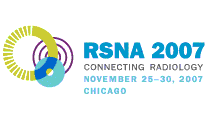
Abstract Archives of the RSNA, 2007
Bijal Patel MD, Presenter: Nothing to Disclose
Ahmed Farooq MD, Abstract Co-Author: Nothing to Disclose
Iain Donald Craik Kirkpatrick MD, Abstract Co-Author: Nothing to Disclose
Blair T. Henderson MD, Abstract Co-Author: Nothing to Disclose
To evaluate the diagnostic accuracy and ability to visualize the pancreaticobiliary system of respiratory-triggered 3D turbo spin echo (TSE) and 2D half-fourier acquisition single-shot turbo spin echo (HASTE) MRCP sequences by correlating with endoscopic retrograde cholangiopancreatography (ERCP).
A retrospective review of 30 patients (13 men, 17 women, mean age 52 yrs.) who underwent both 3D and 2D MRCP at 1.5 T as well as ERCP was performed. Two radiologists independently evaluated the MRCP studies in a blinded fashion. The pancreatiobiliary ducts were divided into six segments. Diagnositc assessment of the segments was performed. Visibility of the segments was graded on a 3 point system; not, partially and completely visualized. ERCP findings by the gastroenterologist were used as the gold standard for diagnostic assessment. A Student t test was used to compare the visibility of duct segments as well as the number of segments visualized per patient.
Using ERCP as the gold standard, the overall sensitivity and specificity of 3D TSE (sens. 96%, spec. 91%) was superior to that of 2D HASTE sequence (sens. 83%, spec. 83%). Radiologist B demonstrated improved visibility (P<0.05) of the left and right hepatic ducts, common hepatic duct, and intrahepatic ducts with 3D TSE compared to 2D HASTE. In addition to the same duct segments, Radiologist A demonstrated improved visibility of the ampulla (P<0.05). 3D TSE imaging produced an improved overall visibility of 0.3 (on a 3 point scale) over 2D HASTE (P<0.05). Overall, there was a slight but significant increase in the number of duct segments visualized per patient of 0.3 out of a possible six segments (P<0.04) with 3D TSE. End diagnoses determined by ERCP were as follows: no abnormality (n=10), chronic pancreatitis (n= 5), ampullary stenosis (n=5), stricture common bile/hepatic ducts (n=1), choledocholithiasis (n=8), sclerosing cholangitis (n=1).
3D TSE MRCP demonstrates superior ductal visibility and improved sensitivity and specificity compared to the 2D HASTE sequence using ERCP as the gold standard.
3D TSE MRCP improves diagnostic assessment of the pancreaticobiliary ducts compared to the 2D HASTE sequence.
Patel, B,
Farooq, A,
Kirkpatrick, I,
Henderson, B,
3D Turbo Spin Echo Compared to 2D Half-fourier Acquisition Single-shot Turbo Spin Echo MRCP: Correlation with Endoscopic Retrograde Cholangiopancreatography. Radiological Society of North America 2007 Scientific Assembly and Annual Meeting, November 25 - November 30, 2007 ,Chicago IL.
http://archive.rsna.org/2007/5003260.html

